by Sheila Dunning | Jun 14, 2022
Florida is rapidly urbanizing with 1,000 people a day moving into the state. Many cities in the panhandle have experienced accelerated growth rates over the past ten years. Crestview is one of the seven areas in the state with a population growth of 19% or greater, and the only one located in the panhandle. The 2030 predictions for Florida are another 6 million people, with counties containing military personnel increasing the quickest.
All of these people need water to meet their daily living needs. The average person in the United States uses 101.5 gallons of water per day. Residential water use comprises 61% of the public supply category. This category is responsible for the largest single portion (43%) of groundwater withdrawal in Florida. The Floridan aquifer spans an area of about 100,000 square miles in the southeastern United States, including all of Florida, as well as, portions of three other states. At the current statewide population growth rate, Florida is facing a 300 million gallon per day shortfall of future water needs, possibly as early as 2030.
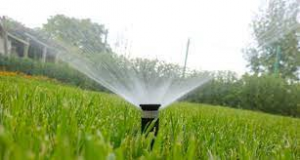 Turfgrass is a key landscape component and often the most commonly used single type of plant in the residential landscape. However, on a hot, sunny day in midsummer, the average lawn uses 125 gallons of water per 1,000 square feet. Although Florida has a humid climate where the precipitation rate, on average, is greater than the evapotranspiration rate, the low water-holding capacity of the soil makes irrigation necessary for the high quality landscapes desired by homeowners. But, watering the yard requires an entire household to skip a shower, not wash anything and avoid cleaning. Or, we need to find ways to use a different source of water for irrigation and conserve the potable water for the people.
Turfgrass is a key landscape component and often the most commonly used single type of plant in the residential landscape. However, on a hot, sunny day in midsummer, the average lawn uses 125 gallons of water per 1,000 square feet. Although Florida has a humid climate where the precipitation rate, on average, is greater than the evapotranspiration rate, the low water-holding capacity of the soil makes irrigation necessary for the high quality landscapes desired by homeowners. But, watering the yard requires an entire household to skip a shower, not wash anything and avoid cleaning. Or, we need to find ways to use a different source of water for irrigation and conserve the potable water for the people.
While the use of reclaimed water for landscape plants has become a standard in many parts of Florida, it has limited availability in the panhandle. However, there are many ways to reduce and conserve potable water use for those with in-ground irrigation systems. First, make sure you have a functional rain shut-off device. By design it will prevent the system from running when it has recently rained. On average, the panhandle has received rain about every 4 days this year. Besides, Florida law requires a rain shut-off device for all irrigation systems, new or old.
Then, calibrate each zone to determine the length of time required to deliver ½ inch of water. This can be determined by placing 10 or more, short, straight-sided containers throughout the irrigation zone. Run the system and look at each container, measuring the depth with a ruler. Adjust the run time so the system only delivers ½ inch. Now set the clock to run 2-3 times a week for that length of time. It’s that simple. And the water savings is significant. For these and many other irrigation tips, visit askIFAS at https://edis.ifas.ufl.edu/.
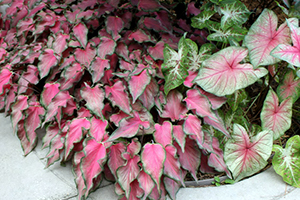
by Sheila Dunning | May 5, 2022
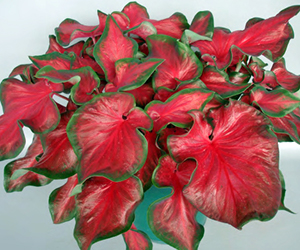 The arrow-shaped leaves of the caladium can add low-maintenance color to the landscape for months. Most effective when massed together in the landscape, caladiums are available in many unique patterns and vibrant colors. A multitude of leaves emerge from a single tuber in various shades of red, white and pink. There are those with spots, ones with bright veins and others with dark green edges. Imagine a pattern, there is probably a caladium to match. Originally discovered in the Amazon River basin, these fast-growing plants can bring life to a shady spot or add drama to the edge of a sunny bed.
The arrow-shaped leaves of the caladium can add low-maintenance color to the landscape for months. Most effective when massed together in the landscape, caladiums are available in many unique patterns and vibrant colors. A multitude of leaves emerge from a single tuber in various shades of red, white and pink. There are those with spots, ones with bright veins and others with dark green edges. Imagine a pattern, there is probably a caladium to match. Originally discovered in the Amazon River basin, these fast-growing plants can bring life to a shady spot or add drama to the edge of a sunny bed.
Caladium plants usually grow 1-2.5 feet high with leaves that measure 6-12 inches in length. Most caladiums thrive in partial shade. But, many new cultivars have been bred to grow in direct sunlight for many hours of the day. Plant breeders, including researchers at the University of Florida, release new cultivars each year. Many of them are patented.
Cultivars are broadly separated into two main categories: fancy and lance-leafed, also referred to as strap-leafed. Fancy-leafed cultivars have large heart-shaped leaves. Lance-leafed cultivars have narrow, elongated leaves. So, when choosing a caladium, there are many decisions to make: sun or shade; short, medium or tall; pattern or solid color; and leaf shape.
Some the traditional fancy-leafed caladium cultivars include: ‘Aaron’, a medium white with a large dark green edge; ‘Carolyn Whorton’, a medium pink blotched leaf; and ‘Postman Joyner’, a medium red with large veins extending into the dark green edge. These are suitable for more sunlight.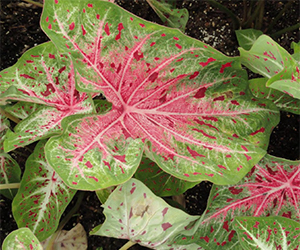
On the extreme other side are the shade-loving speckled strap-leafed cultivars like ‘Miss Muffet’, ‘Gingerland’ and ‘Sea Foam Pink’, a newer UF developed cultivar. For more information on the caladium cultivars developed at UF go to: https://gardeningsolutions.ifas.ufl.edu/plants/ornamentals/caladium-cultivars.html. Keep an eye on children and pets when they are around the caladium plants. The leaves are toxic if ingested.
Plant caladium tubers in spring once the soil is at least 60-70 degrees F. Place them “eye side” up. That is the side that is all lumpy. If you want shorter, compact plants that don’t show as much stem, “de-eye” and dry the tubers for a day before planting them. That means scoop out the peak of the mound. This will force the remaining buds to sprout around it. Place the tubers in the ground 2 inches deep and 8-12 inches apart. Once they have sprouted, apply a light fertilizing once or twice over the summer. Choose a fertilizer that contains a slow-release nitrogen and is low in phosphorus. Excess nutrients will force the leaves to become greener, losing all the unique colors and patterns.
At the end of the season the leaves will decline and go dormant naturally. The tubers can be left in the ground, but if they experience a cold and/or wet winter, expect losses. Digging them will ensure that there will be tubers for next year. The tubers should be dusted with a sulfur fungicide prior to being stored in dry peat moss or vermiculite at temperatures between 50 and 60 degrees F.
 If you want to learn more about caladiums and have an opportunity to purchase the Proven Winner new introductions from 2021 and 2022, join me at the Destin Garden Club meeting on May 10, 2022. The program will be held at the Resurrection Catholic Church, 259 Miramar Beach Dr. Miramar Beach, FL beginning at 9 a.m.
If you want to learn more about caladiums and have an opportunity to purchase the Proven Winner new introductions from 2021 and 2022, join me at the Destin Garden Club meeting on May 10, 2022. The program will be held at the Resurrection Catholic Church, 259 Miramar Beach Dr. Miramar Beach, FL beginning at 9 a.m.
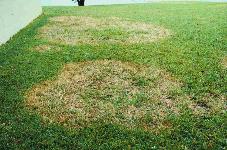
by Sheila Dunning | Mar 31, 2022
 As the temperatures warm into the 70’s and the rain chance remains good, keep an eye open for disease in your lawn. Large patch disease is common in turfgrass this time of the year. It is caused by the fungus Rhizoctonia solani. The fungus is present in the soil and thatch layer year-round. When the temperatures rise into the 60’s and 70’s it begins to spread. Large patch thrives under these conditions, especially when the soil is wet. With frequent showers the disease spreads quickly. The first symptom of large patch is circular, discolored areas within the lawn. The outer borders of the patches are orange to yellowish in color. In the center of the circle there are grass blades trying to green up again. They are usually unsuccessful, resulting in odd-shaped patches of dying grass that begin to connect to each other. A simple field diagnostic techniques to confirm large patch disease is to pull on the diseased grass shoots near the edge of the circle. The blades will come loose from the stolon easily. At the base of the leaves the stem and sheaths will appear dark brown and rotten. Yes, it is large patch.
As the temperatures warm into the 70’s and the rain chance remains good, keep an eye open for disease in your lawn. Large patch disease is common in turfgrass this time of the year. It is caused by the fungus Rhizoctonia solani. The fungus is present in the soil and thatch layer year-round. When the temperatures rise into the 60’s and 70’s it begins to spread. Large patch thrives under these conditions, especially when the soil is wet. With frequent showers the disease spreads quickly. The first symptom of large patch is circular, discolored areas within the lawn. The outer borders of the patches are orange to yellowish in color. In the center of the circle there are grass blades trying to green up again. They are usually unsuccessful, resulting in odd-shaped patches of dying grass that begin to connect to each other. A simple field diagnostic techniques to confirm large patch disease is to pull on the diseased grass shoots near the edge of the circle. The blades will come loose from the stolon easily. At the base of the leaves the stem and sheaths will appear dark brown and rotten. Yes, it is large patch. 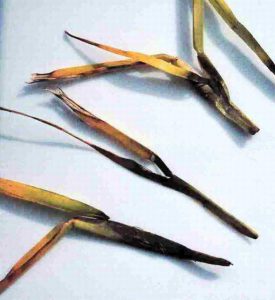 If the weather gets colder or hotter very quickly, the disease will go back into dormancy. Looking at the long range temperature predictions, cool night and warm days are likely to continue for awhile. So, start looking for a fungicide or two or contact your pest control service. However, remember fungicides don’t cure existing problems. They are utilized as a protectant for the unaffected portions of the grass. When favorable conditions are present, the turf should be sprayed in order to keep the fungus from penetrating the grass blades. Repeat applications will be needed for as long as the weather is cool and wet. Check the product label for the correct intervals. Several cultural practices promote large patch infection including over-fertilization, over-irrigation, low mowing height, poor drainage and excess thatch. This spring after the grass has greened-up on its own is a good time to look at these factors and make corrections. Keep a close eye because as soon as the temperatures drop again in the fall, large patch can reappear if the corrections were not complete. For more information: https://edis.ifas.ufl.edu/lh044
If the weather gets colder or hotter very quickly, the disease will go back into dormancy. Looking at the long range temperature predictions, cool night and warm days are likely to continue for awhile. So, start looking for a fungicide or two or contact your pest control service. However, remember fungicides don’t cure existing problems. They are utilized as a protectant for the unaffected portions of the grass. When favorable conditions are present, the turf should be sprayed in order to keep the fungus from penetrating the grass blades. Repeat applications will be needed for as long as the weather is cool and wet. Check the product label for the correct intervals. Several cultural practices promote large patch infection including over-fertilization, over-irrigation, low mowing height, poor drainage and excess thatch. This spring after the grass has greened-up on its own is a good time to look at these factors and make corrections. Keep a close eye because as soon as the temperatures drop again in the fall, large patch can reappear if the corrections were not complete. For more information: https://edis.ifas.ufl.edu/lh044
The Institute of Food and Agricultural Sciences (IFAS) is an Equal Opportunity Institution authorized to provide research, educational information and other services only to individuals and institutions that function with non-discrimination with respect to race, creed, color, religion, age, disability, sex, sexual orientation, marital status, national origin, political opinions or affiliations. For more information on obtaining other extension publications, contact your county Cooperative Extension service.
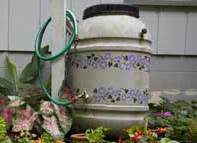
by Sheila Dunning | Feb 24, 2022
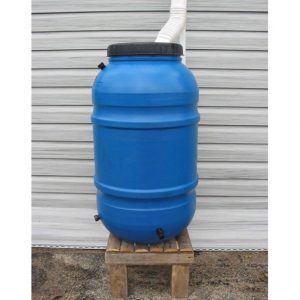
Rain Barrel made from food grade container.
A great way to save money on your water bill and reduce the amount of water withdrawn from the aquifer is to use a rain barrel. The water savings from using stored rainwater rather than municipal or well water can be substantial over a period of time. A rain barrel may not provide all the water needed to sustain all your plants, but it can certainly benefit some houseplants or even an entire vegetable garden. If you currently have a standard irrigation system, you may be able to turn off the sprinkler zones that are in flower beds and use stored rainwater instead.
Typically, the rain barrel is connected to the gutter downspout of the house. For a general calculation, you can collect about a half-gallon of water per square foot of roof area during a 1 inch rainfall. A typical ½ inch rainfall event will fill a 50-55 gallon barrel. Multiple rain barrels can be linked together with PVC or flexible hose to increase storage capabilities. However, with a screen modification on the lid, the rain barrel can be located anywhere in order to collect open rain fall. It will take a lot longer to fill, but may be more practical if the area you want to water is a good distance from the house.
Now is the time to prepare for the long, hot season to come. If you want to learn more, please join the Walton County Environmental Department and UF/IFAS at the Walton County Extension office on Monday, March 7, 2022 for an educational lecture on stormwater and demonstration on how to build a rain barrel. The first 20 participants may also sign up to build a take-home rain barrel. The program begins at 1:00 pm and is free to the public. Those interested in assembling a ready-to-go rain barrel will need to pay $35. Custom assembly will begin at 3:30 p.m. Please contact the Walton County Extension office to register. 850-892-8172.
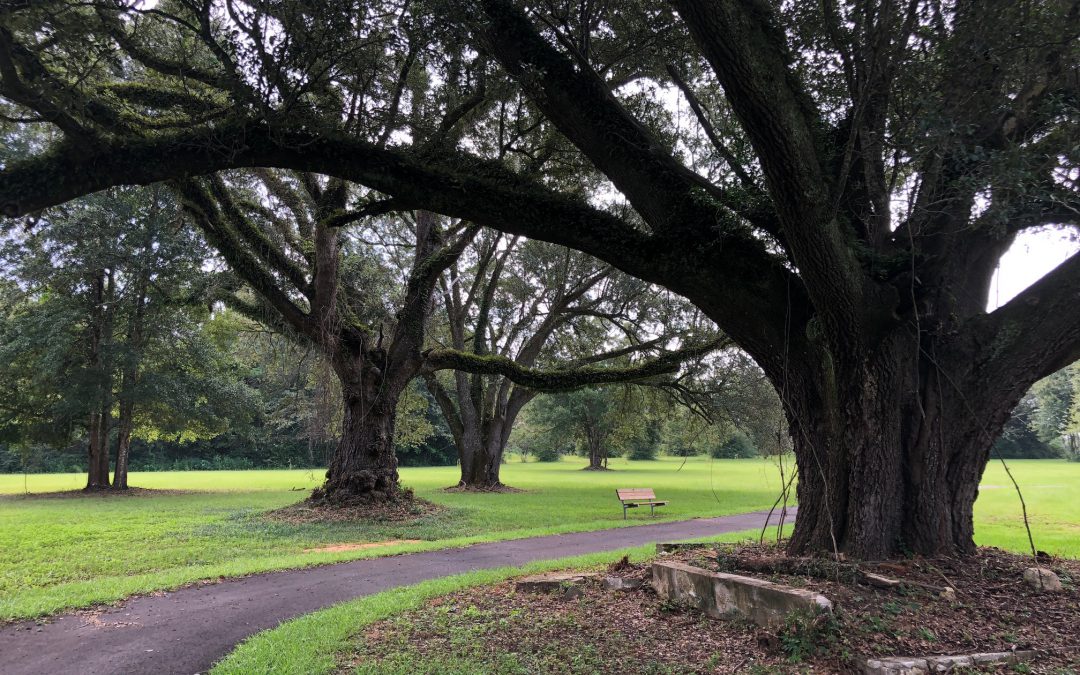
by Sheila Dunning | Dec 31, 2021
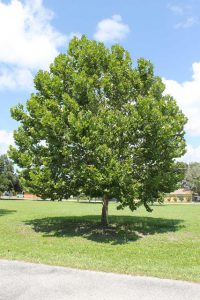
Even with this young sycamore, you’ll be made in the shade. Credit: UF/IFAS.
The best time to plant a tree is twenty years ago. The second-best time is Arbor Day. Florida recognizes the event on the third Friday in January but planting any time before spring will establish a tree quickly.
Arbor Day is an annual observance that celebrates the role of trees in our lives and promotes tree planting and care. As a formal holiday, it was first observed on April 10, 1872, in the state of Nebraska. Today, every state and many countries join in the recognition of trees impact on people and the environment.
Trees are the longest living organisms on the planet and one of the earth’s greatest natural resources. They keep our air supply clean, reduce noise pollution, improve water quality, help prevent erosion, provide food and building materials, create shade, and help make our landscapes look beautiful. A single tree produces approximately 260 pounds of oxygen per year. That means two mature trees can supply enough oxygen annually to support a family of four.
The idea for Arbor Day in the U.S. began with Julius Sterling Morton. In 1854 he moved from Detroit to the area that is now the state of Nebraska. J. Sterling Morton was a journalist and nature lover who noticed that there were virtually no trees in Nebraska. He wrote and spoke about environmental stewardship and encouraged everyone to plant trees. Morton emphasized that trees were needed to act as windbreaks, to stabilize the soil, to provide shade, as well as fuel and building materials for the early pioneers to prosper in the developing state.
In 1872, The State Board of Agriculture accepted a resolution by J. Sterling Morton “to set aside one day to plant trees, both forest and fruit.” On April 10, 1872, one million trees were planted in Nebraska in honor of the first Arbor Day. Shortly after the 1872 observance, several other states passed legislation to observe Arbor Day. By 1920, 45 states and territories celebrated Arbor Day. Richard Nixon proclaimed the last Friday in April as National Arbor Day during his presidency in 1970.
Today, all 50 states in the U.S. have official Arbor Day, usually at a time of year that has the correct climatological conditions for planting trees. For Florida, the ideal tree planting time is January, so Florida’s Arbor Day is celebrated on the third Friday of the month. Similar events are observed throughout the world. In Israel it is the Tu B Shevat (New Year for Trees). Germany has Tag des Baumes. Japan and Korea celebrate an entire week in April. Even Iceland, one of the treeless countries in the world observes Student’s Afforestation Day.
The trees planted on Arbor Day show a concern for future generations. The simple act of planting a tree represents a belief that the tree will grow and someday provide wood products, wildlife habitat, erosion control, shelter from wind and sun, beauty, and inspiration for ourselves and our children.
“It is well that you should celebrate your Arbor Day thoughtfully, for within your lifetime the nation’s need of trees will become serious. We of an older generation can get along with what we have, though with growing hardship; but in your full manhood and womanhood you will want what nature once so bountifully supplied and man so thoughtlessly destroyed; and because of that want you will reproach us, not for what we have used, but for what we have wasted.”
~Theodore Roosevelt, 1907 Arbor Day Message
 Turfgrass is a key landscape component and often the most commonly used single type of plant in the residential landscape. However, on a hot, sunny day in midsummer, the average lawn uses 125 gallons of water per 1,000 square feet. Although Florida has a humid climate where the precipitation rate, on average, is greater than the evapotranspiration rate, the low water-holding capacity of the soil makes irrigation necessary for the high quality landscapes desired by homeowners. But, watering the yard requires an entire household to skip a shower, not wash anything and avoid cleaning. Or, we need to find ways to use a different source of water for irrigation and conserve the potable water for the people.
Turfgrass is a key landscape component and often the most commonly used single type of plant in the residential landscape. However, on a hot, sunny day in midsummer, the average lawn uses 125 gallons of water per 1,000 square feet. Although Florida has a humid climate where the precipitation rate, on average, is greater than the evapotranspiration rate, the low water-holding capacity of the soil makes irrigation necessary for the high quality landscapes desired by homeowners. But, watering the yard requires an entire household to skip a shower, not wash anything and avoid cleaning. Or, we need to find ways to use a different source of water for irrigation and conserve the potable water for the people.









